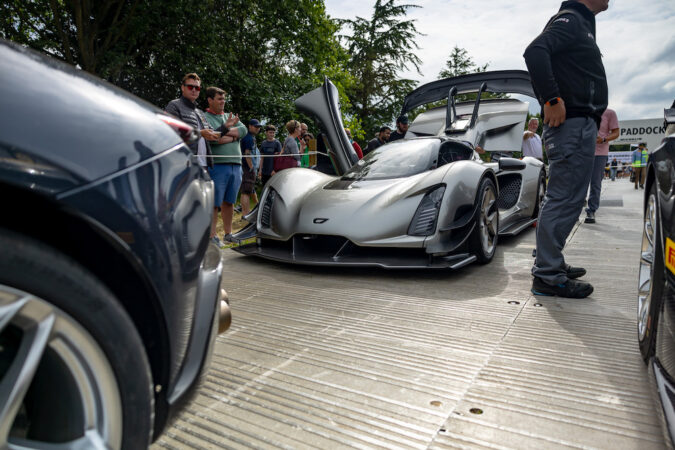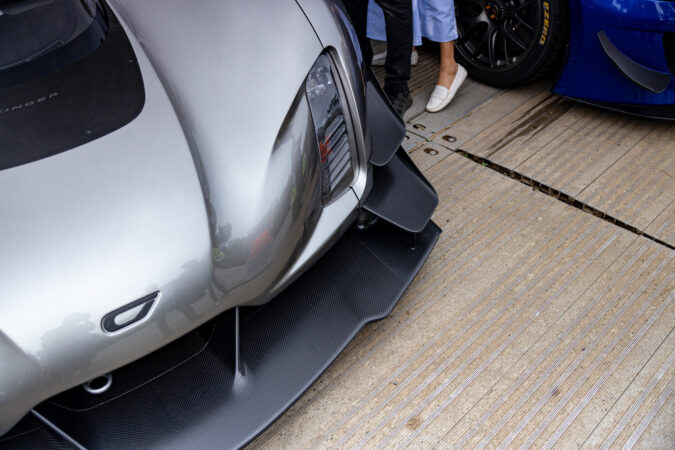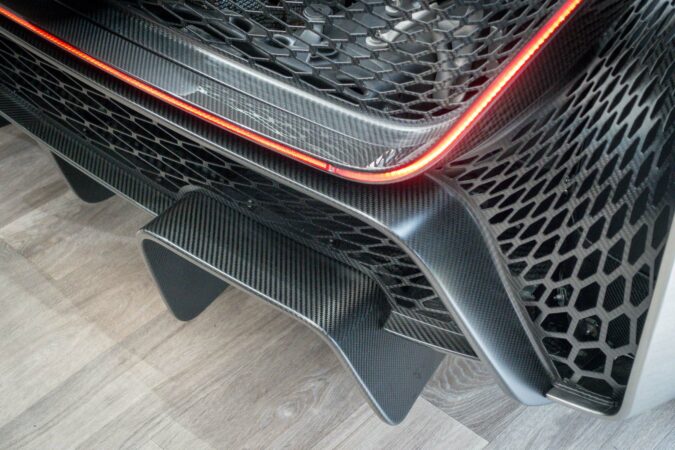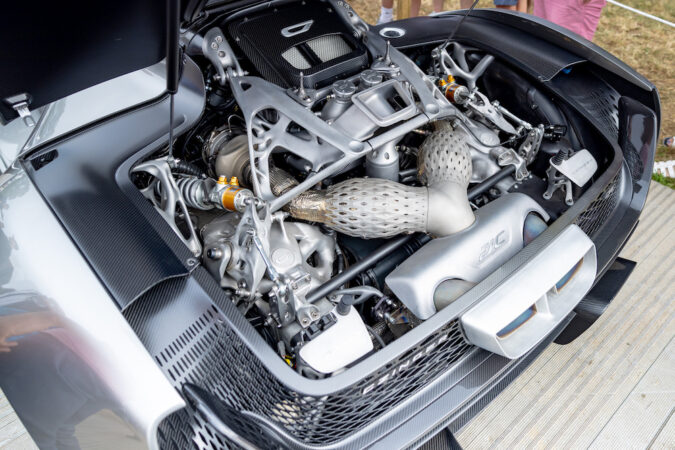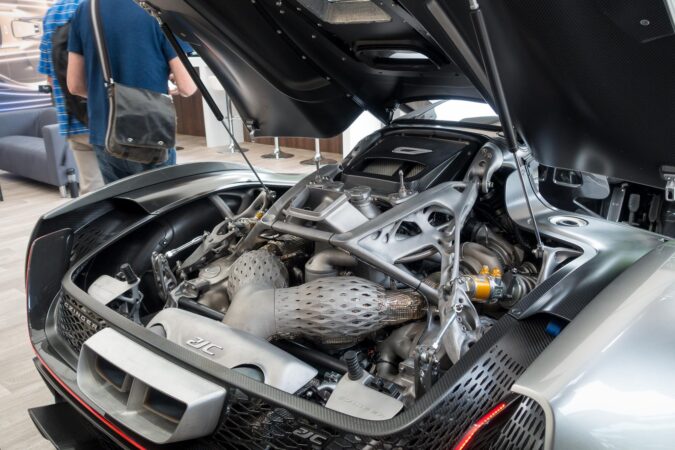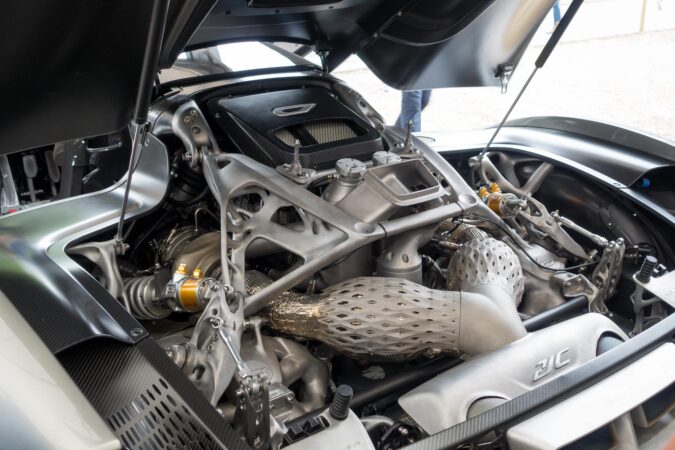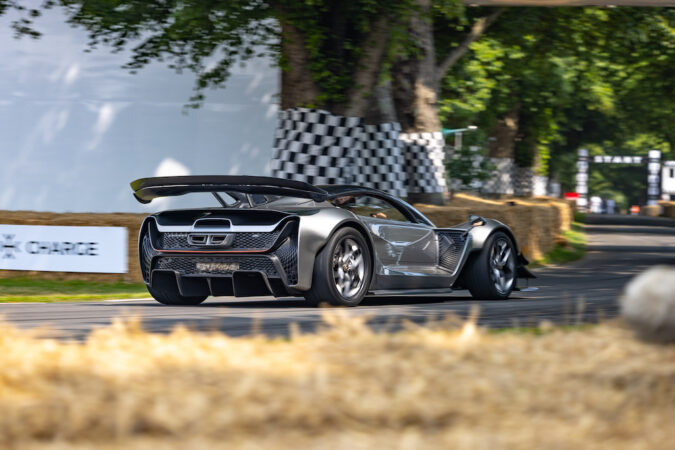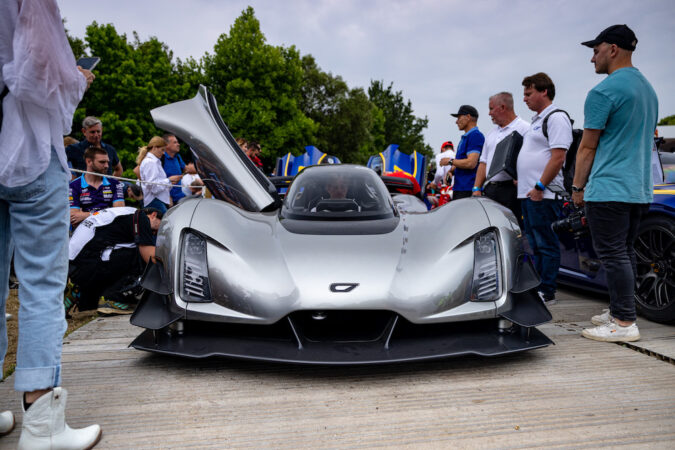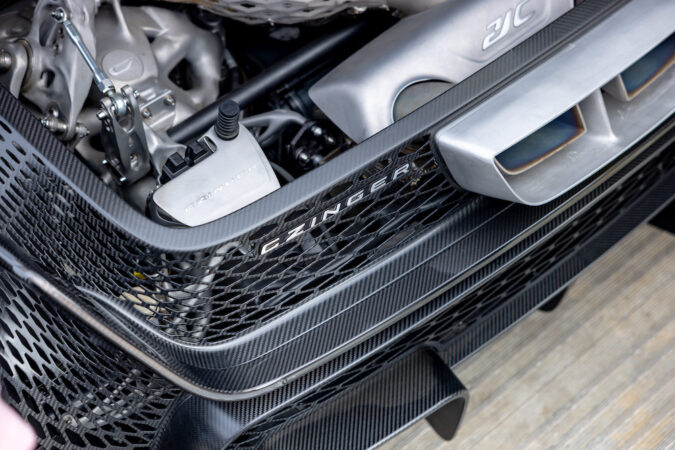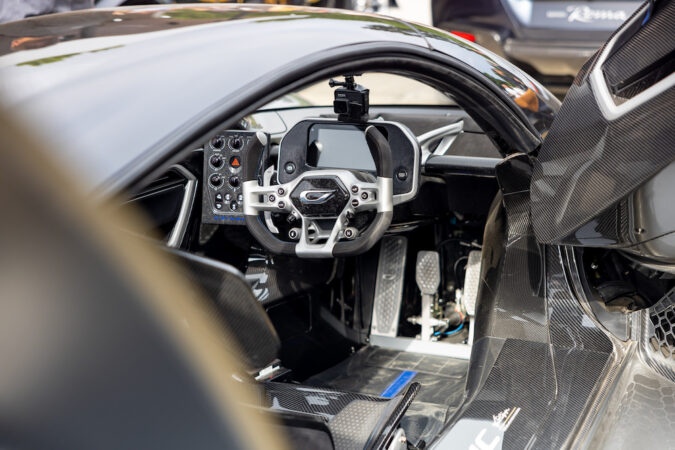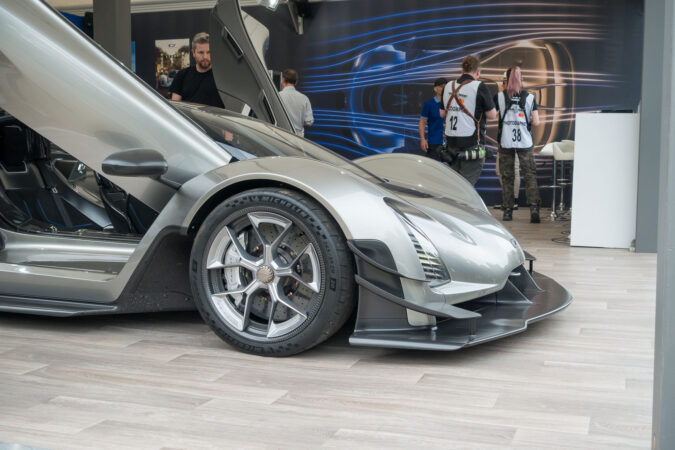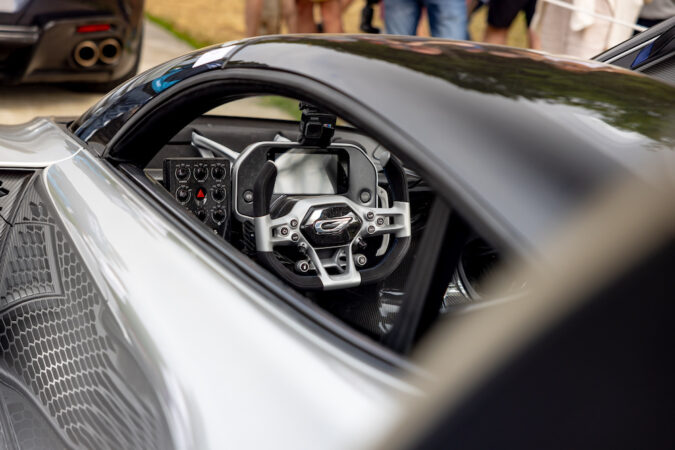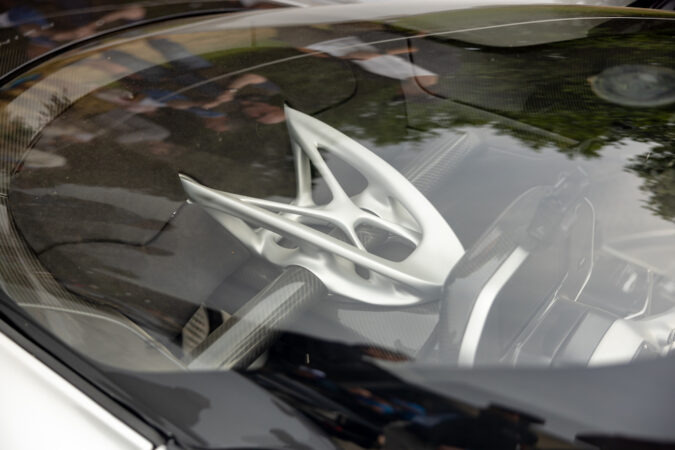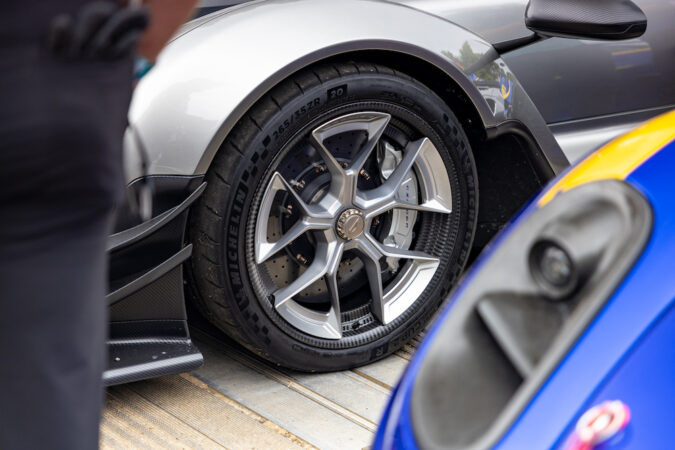When you hear about a father and son team working together to build a car, you’d commonly conjure up an image of a small shed or garage. Perhaps, your mind thinks of all the tools strewn about, grease dripping onto the floor, a bare chassis laying dormant, with a half-put-together engine in the corner. It paints a rustic scene, and while the Czinger 21C shares a somewhat similar upbringing, this is no kit car.
They’re very much a family business, with a father-and-son duo, Kevin and Lukas Czinger behind it. I had the chance to speak to them over the weekend at the Goodwood Festival of Speed. And, I had the opportune peek of a lifetime behind the iron curtain to see what their upstart family business is up to. To say that what they’ve created here with the 21C is awe-inspiring, is putting it quite lightly, I think.
To sum it up in one go, the Czinger 21C is one of the maddest hypercars that you’ll ever get to see. It’s a mid-engine design, featuring a hybridised powertrain mated to a power-dense twin-turbo V8. Below that sits a cleverly designed 3D printed chassis that’s both strong and lightweight. Plus, it’s got all the performance, dynamics, and aero that you’d expect out of a car that looks like it came from the Batcave.
3D Printing Here, There, And Everywhere
So, where do we even start with the Czinger 21C? Well, we may as well begin with what underpins the sheer speed and athleticism of the 21C – its chassis and bodywork. These days, 3D printing is slowly spreading within the automotive industry. However, even among A-tier supercar brands, 3D printing is usually relegated to the mostly inconsequential and cosmetic bits and pieces of a car.
For example, using 3D printing to create a complex centre console and dash, or perhaps having its additive benefits be used for specific body parts. It’s not commonplace (at least, not yet) for any cars to be practically built from the ground up using 3D printing. But this is exactly what Czinger did with the 21C. Specifically, most of the chassis and suspension are made through 3D printing.
If you look underneath, you’ll note how its 3D-printed chassis is laid out like what you might find on an old-school tubular space frame (but way cooler). The goal here is to reduce material usage by as much as possible. But, without affecting rigidity, as is proven by the fact that the 3D-printed upper chasis frame section is basically hollow. It shows just how hard the team at Czinger has worked to synthesize the best alloys feasible and apply them using the brightest minds and fastest computers.
Interestingly, the fact that it’s 3D printed means that Czinger is able to fabricate complex shapes and designs. Just like that hollowed-out control arm, the framing could allow for fluids and wiring to pass right through them, which wouldn’t be possible with conventional construction methods. Moreover, and since the 3D printed chassis runs through and into the engine bay, it has to be able to cope with the heat, as well.
Super Lightweight And Super Fast
So, what happens when you experiment with this much 3D printing, so much so that no other car that I’ve heard of could barely even match it? Well, the Czinger 21C is light, very light. Alongside the extensive use of carbon fibre composites, the 21C tips the scale with a dry weight of just around 1,250kg. This is made even more impressive when you consider what powertrain the 21C’s got running underneath.
Czinger aimed to hit a 1:1 power-to-weight ratio, which they’ve handily done in the 21C. In the back, it remains a tad old-school, with a mid-mounted, twin-turbo V8. Once you dig a bit deeper, it’s only then that you’ll find how nerdy the engine really is. The ICE component is a 2.88-litre block, and it’s got a flat-plane crank, alongside two turbochargers. This makes it the most power-dense production engine in the world.
Furthermore, Czinger then mates this to an 800V hybrid system, combining both drive and regen in an enclosed unit. Specifically, it has three electric motors. There’s one paired to the engine (which we call a Motor Generator Unit, or MGU) that supports the V8. Meanwhile, there are two motors in the front, one for each axle. There’s also a battery pack, which is charged through regenerative braking.
Altogether, the Czinger 21C is able to output a whopping 1,250hp (which is around 1,233bhp). Should power alone not be enough to tickle your pickles, know that the 21C revs up to a spine-tingling 11,000 RPM. And just so it’s able to dole out all that beef as efficiently as possible, the powertrain is paired to a 7-speed sequential transmission. But, you might ask… Just how (lighting) fast is the 21C, then?
More Than Enough Speed
The answer – it’s incredibly fast. Oh, and it’s not just marketing speak either. Owing to that 1:1 power-to-weight ratio, as well as the extensive work done to fine-tune the suspension, braking, steering, and a lot more besides, the 21C has already set not one, but two production car lap records. At Laguna Seca, Czinger’s 21C clocked a lap time of 1:25:44, making it 2 seconds faster than the mighty McLaren Senna.
All the while, they also clocked a record-breaking lap at the Circuit of the Americas, beating the prior record-holder (a McLaren P1) by an incredible 6 seconds. If you want to know the specifics, the 21C is able to sprint from standstill to 60mph in a blistering 1.9 seconds. On top of that, it’ll zoom from 0 to 186mph in a mere 8.5 seconds. If you’re counting from 0 to 186mph and back to 0, it’s still a speedy 13.8 seconds.
Comparing that with other hypercars, Czinger is quick to tell you that the 21C will do an impressive 0 to 248mph (that’s 400km/h) and back to 0 again in a mind-boggling 27.1 seconds. It’s much faster when compared to Koenigsegg’s attempt with the Regera a while back, in a comparatively lethargic 31.49 seconds. It’s mad to think how fast cars have become these days, but it’s not simply magic.
One of the Czinger 21’s noteworthy features – besides everything else we’ve just mentioned – is all the aerodynamics at work. At just 100mph, the 21C could generate up to 615kg worth of downforce. But, when you notch it up to its most aggressive setting, the 21C could achieve over 2,500kg in downforce at 200mph. As for top speed, the Czinger 21C could theoretically peak at 253mph.
Want Even More Performance?
However, there’s also another, even higher top speed figure being thrown around when mentioning a 21C – 281mph. This is possible, but only if you opt for the optional low-drag configuration. This should be the most ideal version of the 21C that you should buy (if you have pockets deep enough) when you want to spend a bit more time with it on the track. This is just one of two different specs of the 21C.
The other being the one you see in the snapshots, which is Czinger’s idea of a high-downforce kit. This is your standard, by-default, factory spec, one would say. Granted, you may not have guessed it from how stripped-out, racecar-like, and barebones the interior is. In the driver’s seat, you get a GT3-style steering wheel. As well as, your auxiliary and vital car controls and switches on a separate panel.
There’s no fancy infotainment system, though you do get a digital dash, just like a race car. You won’t find any leather or plush padding either. Sitting inside, you’re essentially cocooned by bare and glossy carbon fibre. If you want more luxury, the passenger seat should be a cosier place to spend time in. As skinny as the 21C is – the cabin is as narrow as a Le Mans hypercar cockpit – there is a second seat.
Unusually, the passenger seat is placed in tandem behind the driver. Surprisingly, there’s quite a bit of room back there. In stark contrast to its Spartan interior is the 21C’s otherworldly exterior. It looks just as outrageous as every hypercar deserves to be. That should give you some clues as to what it’s capable of. All that 3D printing also denotes a lack of shut lines and panel gaps, as if it was made all in one go.
Rarer Than A Hen’s Tooth
If you do want to get your hands on a Czinger 21C, you’d better grab that chequebook, and hurry. An extreme hypercar like this won’t come all that often, and even more in the case of the 21C. Czinger is only producing 80 examples of the 21C, and maybe 10 of those could come to the UK. For those interested, it has since been announced that H.R. Owen will be Czinger’s exclusive UK-based dealership.
The “cheapest” trim of the 21C will still set you back at least $2 million. But for what it’s able to offer, I dare say that it’s a good price. It’s uncommon to find exotic supercars hailing from America, and let alone one this aspirational. It feels as though nowadays, anyone with enough venture money is building a supercar of some sort. Often, these projects fizzle out and die as quickly as they began.
But in the case of the 21C, they’ve thus far built a complete hypercar out of nowhere, and they have put all the bits of the puzzle together. You’ll most likely find the first 21Cs on the road by 2023, too. Could Czinger break out to become another member of the ultra-exclusive, hyper-car club, like Pagani, Koenigsegg, or Bugatti? Time will tell, but if the 21C is anything to go by, there’s certainly a lot of promise.


